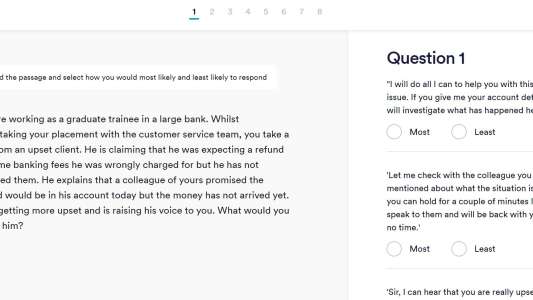When recruiting, employers often want to assess how a candidate might perform in a hypothetical work context or how they might react to a given situation. Situational judgement tests (SJTs) facilitate this by evaluating how you align with the values and behaviours expected by that company.
The situational judgement test will present you with a series of hypothetical workplace scenarios. These could be written, or presented via video (with acted or animated scenarios).
Following the scenario you will then be given a series of actions or conclusions, usually four or five. You will have to either choose which answer you think is most / least appropriate, or to rank the answers (e.g. from most to least effective). There is usually no right answer, but your choice(s) allow the employer to assess your potential fit at the company and get some insight into your approach.
The SJT is not a test you can revise for, as such, but careful preparation will allow you to be unphased and answer the test questions convincingly. Below, we cover ten ways you can enhance your preparation for these types of tests (including situational strengths tests, which are similar). Don’t forget to also check out our tips for taking SJTs.
Step 1: Understand the company
Don’t get ahead of yourself. The first place to start is to research the company that you have applied to and the people that work there. Read the press releases and interviews with senior staff. Consider what tone they take and how they respond to criticism.
What kind of clients does it work with? What is its stance on gender, discrimination and inequalities? Is it a traditional or progressive workplace? All these insights can give you clues as to the sort of people they want to recruit.
Step 2: Find out what provider is used
There are numerous companies that publish SJTs, all with slightly different approaches and styles. If you can find out which provider the company uses, you will be able to tailor your practice questions accordingly.
That said, it’s worth practising a variety of tests, particularly as you don’t want to find out that this is the first year the company is using a new provider. Practising a variety of tests will also give you greater access to more practice questions.
Step 3: Understand your role
Now, think about the role you have applied for. What kind of position is it, managerially speaking? Would you be expected to delegate work or take charge of a situation? How much of a team player will you need to be?
An intern will need a different set of behaviours than a senior manager might, so consider your role when you are answering the questions.
Step 4: Analyse the job description
Now look at the job description carefully to see whether it gives any further clues. Words such as ‘ambitious’, ‘dynamic’ or ‘self-starter’ might suggest that the company is seeking those comfortable with making bold or riskier decisions with higher-stakes outcomes, working in a fast-paced environment, not afraid to get things wrong, able to call out inequalities and speak up.
Other phrases such as ‘team player’ might indicate the company is more interested in what is achieved rather than who did it. These will all contribute to building up an idea of the kind of person and behaviours the SJT is looking to uncover.
Step 5: Understand yourself
Now think about yourself in relation to these traits. First of all, do you think that sounds like you? If so, you should have no trouble selecting the appropriate responses. Particularly if this is your first job, you might find that there are areas which don’t sound naturally like you – but you could be.
Remember those, and make sure to think in your updated mindset when you answer the SJT. Don’t lie, but live up to your potential.
Step 6: Revise expected values
Consider strong ethics and values. The company’s desired behavioural traits are important, but above those should come the universally recognised concepts of right and wrong, plus others set out by law. These include but are not limited to: being able to identify issues relating to bribery, corruption and data protection.
You should be able to list the values applicable to your profession. Make sure you’re aware of any key values that you should be expected to understand, such as professional secrecy or client confidentiality.
Step 7: Understand how the test will work
Look at our articles giving advice as to how SJTs work and tips for better performance. Make sure you’re comfortable with how the answers can be interpreted. For example, understand which answers are in effect a passive choice (i.e effectively ‘do nothing’), since those are rarely the correct choice.
Step 8: Take a practice test
A good starting place with your study programme is to take a practice test in realistic conditions, without giving the answers much thought beyond your instinctive first choice. Don’t overthink; go with your gut feeling.
Make sure you do this in the allotted time, and then mark your answers. Review your results and identity whether there are any patterns where you’re consistently choosing the ‘wrong’ option.
Step 9: Figure out a strategy and study plan
Can you find a new way of thinking about the answers? Something to prompt you to remember not to choose the passive answer, for example. Then practice as many tests as you can, always coming back to the role and company. Keep reading the notes that come with the tests and reflecting on your improvement.
Remember there may not be an answer which fits what you might actually do – you need to pick the most (or least) appropriate from the list you have been given.
Step 10: Research what your peers say
Read forums like Glassdoor and Student Room to find out what others have to say about the test and their experiences. You could also discuss attributes and values, but remember that not everyone may have good intentions, so be confident in your own research and decisions.


